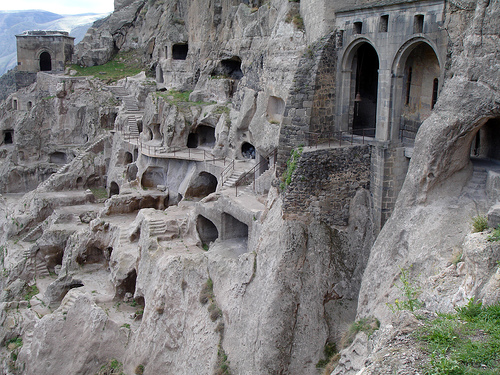Georgia’s Incredible Cave Cities and Cave Monasteries

With today’s modern lifestyle, complete with high-speed trains, iPads, 3g wireless devices, and online gaming, it’s easy to forget that in the past, there were much simpler lifestyles. A visit to any of the many cave cities in Georgia provides a sharp reminder of a not so distant past.
Many of Georgia’s cave cities were simply villages, while others doubled as fortresses or monasteries-double protection from the point of view of the inhabitants. The first of these complexes acted as all three at different points in history. The original focus of the cave city Varzdia had to be its more than 6,000 private residences spread over 13 stories-an impressive feat for any day and age. Originally, the fortress was built to protect the city from Mongol invaders, but an earthquake destroyed the natural protection of the mountainside, allowing the Persians to take the city a couple of centuries later. Although never as vibrant as it was in the 12th century, Varzdia still functions as a monastery and draws thousands of curious travelers.
The David Gareja cave dwelling has been more fortunate in its history. Originally founded by St. David in the 6th century as a monastery, the complex became a battleground during Mongolian and Persian invasions. While much of the vibrancy of the monastery was lost after the Mongol invasion, for most of its 1,500-year history, David Gareja has remained a cultural center of the region. The heart of the complex, however, has always been its ever-expanding number of monasteries. Today, it spans an area of50km by 20km and houses both ancient and relatively modern churches.
These are only two of the cave cities in Georgia. While you are there, you might also want to check out Vanis Kvabebi and Uplistsikhe. For those interested in experiencing what life was like before the Internet, the cave cities of Georgia will provide the perfect opportunity. For the adventurous traveler, there is no end to the exploring one can do in the cave cities and monasteries of Georgia.
For more information on Georgian sites and culture, check out our Teach in Georgia page. While you are there, don’t forget to read more about living and working in Batumi.



3 Responses
Hello, from North Dakota. I wonder if you could give me an approximate monthly salary average for teaching in China, Taiwan and Seoul on the first year?
I graduated from the University of Minnesota last December, 2010 with a BA in Global Studies. I’m 39 years old, so I do have a lot of experience in many other fields since I began working at the edge of 18 y.o. The only experience teaching I have it was 3 months (last summer) when I taught basic computer skills to non English speakers. Other than that, I do speak German, French, Spanish, and comprehend some Italian and Portuguese. I have traveled to many countries throughout my life, but this opportunity now that I have a degree is very tempting. My major concern is to not make enough after paying rent, utilities and food there to pay my student loans here in the States. You can find me on Skype as well. My Skype name is: Achtung863 and my email is: price385@umn.edu.
Hi Allan,
Your monthly salary depends on a lot of different things: School location, teaching package, and the type of visa you’re on will all affect how you are paid. You could be making anywhere between 6,000RMB-16,000RMB depending on your teaching experience and qualifications.
Hi,
I would like to read more about teachers’ experience in Georgia. I am particularly interested in what the condition of the schools are, the teachers’ host families, the safety in Georgia, and how Americans are treated in Georgia. Can you please connect me with teachers currently working there? Thank you. -K